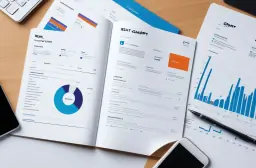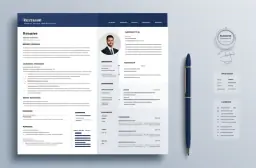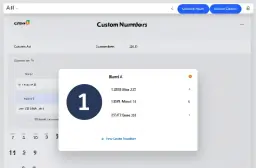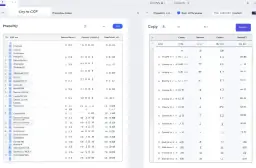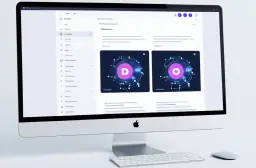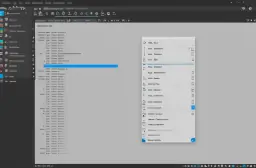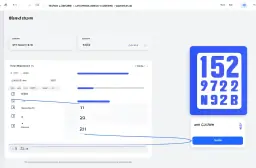Resume & Portfolio Tips for Career Success in 2024

Table of Contents
1. Understanding the 2024 Job Market Landscape
The job market in 2024 continues to be shaped by automation, remote work, and digital-first hiring practices. Companies are increasingly using AI-driven applicant tracking systems (ATS) and behavioral analytics to shortlist resumes.
1.1 Data-Driven Hiring Preferences
Recruiters now prefer succinct, results-oriented resumes. According to a 2024 Glassdoor study, 72% of hiring managers spend less than one minute reviewing a resume. This means your top achievements must shine within the first half of the page.
1.2 AI and ATS Optimization
With over 95% of Fortune 500 companies using ATS, resumes and portfolios must include job-relevant keywords that align with the job description. Resume optimization is critical to ensure your documents make it past automated screening.
1.3 Emphasis on Soft Skills and Personal Branding
A 2023 LinkedIn survey found that 92% of talent professionals believe soft skills matter as much or more than hard skills. Your documents must subtly showcase your leadership, adaptability, and communication abilities.
2. Resume Tips That Get You Hired
Resume & Portfolio Tips start with mastering the structure, design, and content of your resume. We need to think like recruiters and algorithm engineers simultaneously.
2.1 Formatting for Readability and AI
- Use clean, minimalist templates with sans-serif fonts like Arial or Calibri.
- Avoid graphics or tables that ATS can’t read.
- Keep your resume to one page unless you’re in a senior or academic role.
2.2 Content Strategy: Achievements Over Duties
Highlight outcomes, not just responsibilities.
- Instead of: Managed a team of five.
- Write: Led a cross-functional team of 5 to deliver a 32% increase in quarterly productivity.
Use the CAR method (Challenge – Action – Result) to structure bullet points.
2.3 Tailoring to the Job Description
Each resume must be customized. Use the company’s exact keywords and phrasing. For instance, if the JD mentions “content strategy,” include that phrase instead of “editorial planning.”
Pro Tip: Use a tool like Jobscan to compare your resume to the job post.
3. Portfolio Advice for Creative and Tech Roles
For creative professionals, designers, developers, marketers, and even project managers, a portfolio is your career canvas.
3.1 What to Include in a 2024 Portfolio
- 3–5 high-impact projects with brief case studies.
- Screenshots, videos, or interactive demos.
- Your role, the challenge, tools used, and results.
Make sure your portfolio tells a story.
3.2 Choosing the Right Platform
- Use Behance or Dribbble for design portfolios.
- Developers can use GitHub or build custom Next.js portfolios.
- Writers can curate work using Contena or WordPress.
Make it mobile-optimized—67% of hiring managers review candidate materials on mobile.
3.3 Visual Design and Branding
Consistent typography, color palette, and layout build professional trust. Incorporate your personal branding elements—logo, tagline, or even a branded resume header.
4. CV Guidance for Global or Academic Careers
While resumes are standard in the U.S., CVs are often used in academia, research, and international roles.
4.1 Structure and Length
-
CVs are typically 2–4 pages.
-
Include sections such as:
-
Publications
- Research Experience
- Grants & Fellowships
- Conferences
4.2 Detailing without Redundancy
Each section should quantify impact, even if it’s academic. For example:
“Published 5 peer-reviewed articles, cited over 450 times (Google Scholar).”
4.3 Tailor to Target Country Norms
In Europe, photos and personal data may be expected, while in the U.S., they are discouraged due to anti-discrimination laws.
5. Career Document Strategies for Branding
A well-aligned resume and portfolio amplify your personal brand.
5.1 Consistency Across Platforms
Ensure consistency between:
- Your LinkedIn profile
- Resume
- Portfolio
- Cover letter
Use the same tone, keywords, and achievements.
5.2 Including a Personal Statement or Bio
A 3-4 sentence summary at the top of your resume or homepage helps define your narrative.
Example: “Detail-oriented data analyst with 5+ years in healthcare analytics, driving decisions through clean, actionable dashboards.”
5.3 Testimonials and Endorsements
- Include quotes from past managers or clients in your portfolio.
- Request endorsements on LinkedIn.
“Kevin’s technical leadership saved us over $40,000 in engineering costs.” – CTO, TechX Corp
6. Resume Writing Techniques for ATS and Humans
To ensure your documents resonate with both machines and hiring managers, we need to implement dual-optimization techniques.
6.1 Keyword Mapping
- Use Google Sheets to build a keyword bank from 5 similar job posts.
- Integrate them organically into your resume.
| Skill Area | High-Frequency Keywords |
|---|---|
| Data Analysis | SQL, Tableau, Python, Data Cleaning |
| Marketing | SEO, Content Strategy, KPIs, Analytics |
| Project Management | Agile, Jira, Stakeholders, Roadmap |
6.2 Resume Optimization Metrics
- Target keyword match rate: ≥80%
- Word count: 475–700 words
- Bullet length: 1–2 lines each
6.3 File Type and Name
- Save your resume as PDF unless instructed otherwise.
- Name it clearly: Firstname_Lastname_Resume_2024.pdf
7. Portfolio Enhancement with Metrics
Portfolio enhancement isn’t just about how it looks—it’s about the data behind your contributions.
7.1 Showing Impact
Include KPIs for each project:
- Redesigned homepage UI, leading to 46% increase in conversion.
- Created product demo video with 38K views and 2.1% CTR on LinkedIn Ads.
7.2 Version Control and Updates
- Update your portfolio every quarter.
- Use versioning to show growth—e.g., “Updated August 2024” in the footer.
7.3 Linking Your Portfolio Strategically
Include it in:
- Resume header
- Email signature
- LinkedIn profile
- QR code on printed resumes (yes, they’re making a comeback!)
8. Job Search Strategies with Resume & Portfolio Integration
A killer resume and portfolio only work when part of a larger job application strategy.
8.1 Multichannel Application Approach
- Apply directly on job boards like Indeed or LinkedIn.
- Reach out via email or LinkedIn to recruiters.
- Attend networking events or virtual job fairs.
8.2 Cover Letter Reinforcement
Customize your cover letter to reinforce what your resume and portfolio say.
- Highlight one case study.
- Share your “why” for applying.
- End with a call to action: “Can we set up a time to discuss how I can support your team’s Q4 roadmap?”
8.3 Tracking and Refining
Use A/B testing for:
- Resume versions
- Portfolio landing pages
- CTA buttons (e.g., “Download Resume” vs. “Let’s Connect”)
Use tools like Notion, Airtable, or Huntr to track your job applications.
FAQs
What’s the ideal resume length in 2024? One page for most roles; up to two for senior or academic positions.
Should I include a photo on my resume in the United States? No. It may violate anti-discrimination laws and is not standard practice in the U.S.
How often should I update my portfolio? Ideally, every quarter or whenever you complete a major project.
Can I use Canva templates for resumes? Yes, but ensure the output is ATS-compatible by testing it through Jobscan or similar tools.
What’s more important: a resume or a portfolio? Both are critical. A resume gets you seen; a portfolio proves your value.
Conclusion
In 2024, success in job applications depends on more than just experience—it’s about strategic presentation. From resume tips like keyword optimization and quantifiable achievements to portfolio advice focused on visual storytelling and metric-driven impact, these career document strategies can dramatically improve your outcomes. By aligning your personal branding, optimizing for both humans and algorithms, and staying consistent across all touchpoints, we position ourselves not just as applicants—but as top candidates.
Key Takeaways
- Tailor resumes using exact keywords from job descriptions.
- Prioritize results-driven, quantified bullet points.
- Use a mobile-optimized, well-branded portfolio with updated case studies.
- Maintain consistency across resume, portfolio, and LinkedIn.
- Optimize for both ATS and recruiter readability with clean formatting and content.

























































